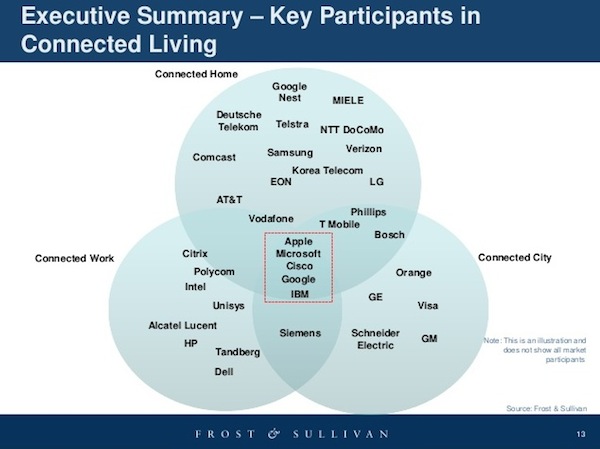Market potential of US$731b in connected living by 2020: Frost & Sullivan
Share
Connected cities, work and homes offer immense opportunities for ICT vendors and telecommunications operators, says new forecast data from strategic consultancy Frost & Sullivan.
Massive technology-led disruption across all industries is moving everyone and everything globally towards a state of ‘connected everything’, the consultancy says, and the next decade will see tens of millions of people connected by trillions of things and applications as a result of connected industries.
The firm forecasts the total connected living market to reach US$731.70 billion by 2020 as the importance of the internet and digital solutions grows in the overall economy.
‘Connected city’ will contribute the largest percentage at 54%, equating to an estimated market potential of $392.94 billion, with smart governance and education services making up 50% of growth in this segment. ‘Connected city’ comprises e-governance, e-citizens, smart transportation cards, e-learning, mobile banking and digital classrooms, remote education services as well as digital libraries.
READ: Internet of things will thrive by 2025: Pew
‘Connected work’ will comprise 31% of the overall market potential, contributing $228.44 billion, and encompasses mobility (mobile email, enterprise mobile apps, people locator, bring your own device), communication (unified messaging, remote desktop access) and networking (web-based project collaboration tools, cloud-based file sharing services).
‘Connected home’ completes the remaining 15% of the overall market potential, at $111 billion. It comprises thermostats, intelligent lighting, remote monitoring and control as well as home health, such as remote diagnostics and wearable health devices.
Audrey William, head of research at Frost & Sullivan’s , Australia and New Zealand ICT practice, says mobility and cloud computing are two pillars of growth that have brought about significant changes in the ICT industry. “Cloud computing, big data, mobility and low cost sensors are driving the internet of things and connected industries, and the internet of things is forcing transformation and innovation across the connected home, connected workplace and connected city,” she says.
Frost & Sullivan predicts that by 2025, the rise of connected living will see 3.7 billion smartphones, 700 million tablets, 520 million wearable health-related devices and 410 million smart appliances in the connected person world.
The connected worker world will see 90 million IP telephones, 400 million laptops and over 60 million unified communication platforms. “Frost & Sullivan expects that nearly 80% of US enterprises will adopt BYOD, 30% of populations will access office networks remotely, and 90% of organisations will offer mobility to workers,” says William.
Meanwhile, the connected citizen will have access to 15 million interactive kiosks enabled by 25 million cloud servers servicing around one billion smart government and ID cards. Around 500 million smart transportation cards and 50 million contact-less payment cards will be issued and an estimated 35 billion subscribed location based services (LBS) devices by 2020.
The value chain of smart solutions to service all the components of connected living is extremely fragmented, says the analysis, with no clear ‘one-stop-shop’ solution provider providing end-to-end solutions. There are many players, ranging from module/component providers to device vendors to network and platform providers to system integrators. Within these groups are big name players such as Sendum, Gemalto, Apple, Samsung, Telefonica, AT&T, Cisco, SAP, Oracle, IBM and Accenture.
In the connected home offering in Australia, players like Telstra and other telecom operators already offer bundled connectivity and entertainment services, while unified communications vendors like Microsoft Lync, Cisco, Mitel, Alcatel Lucent, Shoretel, Interactive Intelligence and Avaya are bringing it all together offering robust and rich solutions that enable the connected worker to experience seamless transitions from various applications to various devices every day.
While the ecosystem of players is complex, William says there is no denying that, collectively, the market potential is huge. “[It] presents immense opportunities for the telecom operators and ICT vendors,” she says.
This diagram shows key players in connected living. The full deck by Frost & Sullivan is below.















